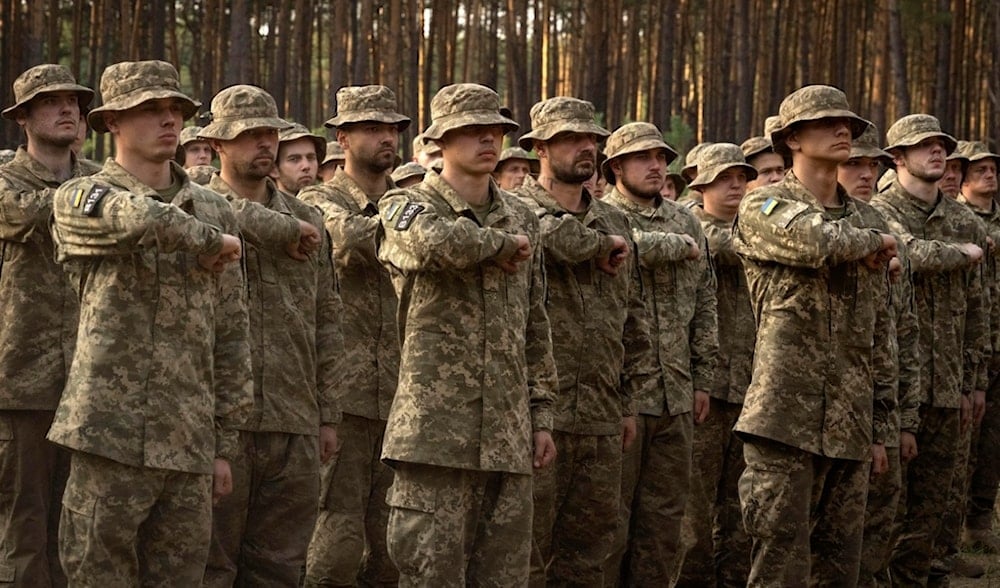Is Ukraine at an impasse in its war against Russia?
While Ukraine is surrounded by military weaknesses, its advancement further against a relatively tougher Russia seems impossible.
-

Newly recruited soldiers of Ukraine's 3rd Assault Brigade shout slogans at a military base close to Kiev, Ukraine, Monday, September 25, 2023. (AP)
When Russia captured Avdiivka, the odds of the Russian-Ukrainian war shifted from a stalemate to a possibility of witnessing a Russian strike, The Economist stated.
Currently, amid a critical state in Ukraine, the country's main goal is "fortification, ammunition, and manpower," Michael Kofman of the Carnegie Endowment for International Peace said.
Ukraine was able to combat Russia's Black Sea Fleet and replenish its air defenses to construct a force that would target Russian critical infrastructure, such as its oil refineries, using homemade drones that compensate for its severe shell depletion. This comes as a direct result of the blockage of US President Joe Biden's $61 billion military aid package by Republicans in Congress, and the European Union's failure to deliver over half a million shells to Ukraine by March.
The military capabilities' absence created a new formula on the ground: For each Ukrainian shell fired, five Russian ones are fired back. While the Biden package remains frozen, and the EU's vows keep getting delayed, Ukraine has only been able to produce 1.4 million shells this year, and Russia has been producing over double that amount.
The Economist suggests one solution to the Ukrainian problem, encompassed in aid from the Czech Republic, which has secured at least 800,000 shells. The Netherlands, Denmark, Germany, and Canada have also allocated funds to help pay. The Czech Republic says that if $3.3 billion could be secured, 1.5 million shells could be purchased and sent to Ukraine.
In this context, Nico Lange, a Ukraine expert working with the German Defense Ministry revealed that batches of these shells have been gradually arriving in Ukraine, giving Ukrainian troops some "breathing space" for the upcoming few months.
Read more: Ukraine's military to collapse without US aid, officials tell WashPo
A depleted arsenal
However, Ukraine is also seeing gaps in other military supplies, such as air defense interceptors. On March 21, when Russia targeted Ukraine's energy system with a barrage of 151 missiles and drones, Ukraine was only able to intercept 92, allowing more attacks on other critical infrastructure in Kiev and Lviv.
To avoid such recurrences, The Economist article suggested that Kiev should strike critical points in Crimea that target logistic axes. However, it almost fully depleted its Storm Shadow and Scalp missiles, donated by France and the United Kingdom.
In this regard, Olaf Scholz, the Chancellor of Germany, has been pushing for his country to provide Ukraine with long-range Taurus missiles. However, concerns were raised, saying that if Germany was to deliver Taurus missiles to Ukraine, it would equate to a war declaration against Russia.
"If German cruise missiles hit targets in Russia, this will actually mean a declaration of war. There is a red line, and, probably, Taurus missiles are the red line, crossing which you become a party to the conflict," politician Sahra Wagenknecht stated.
Ukraine finds itself amid severe shortages on all sides, including military tanks and vehicles, despite the possibility of US aid that is unbound to Congress being delivered to Ukraine soon to alleviate its shortcomings.
Moreover, there were delays in building defensive structures in Ukraine that not even Ukrainian President Volodymyr Zelensky could justify, especially given Russia's demonstrated advantage when defenders operated from fortified positions.
It wasn't until November that the president initiated significant construction efforts, involving engineering troops and civilian contractors. The implementation of an integrated defense system, comprising anti-tank barriers, obstacles like "dragon's teeth," minefields, firing positions, and earthworks for infantry protection, is currently underway at a sluggish pace.
Read more: West acting out of self-interest in Ukraine: Borrell
Ukrainian troops avoid service
Russia declared that between 300,000 to 400,000 additional soldiers enlisted in the Russian army, forming a new army force to combat Ukraine. On the other hand, Ukraine has experienced difficulties in recruitment.
Although 30,000 Ukrainian soldiers have been deployed each month to push off "meat attacks" after the Avdiivka loss, out of a 900,000-soldier army, only 300,000 have been to war, while authorities push to recruit additional forces.
The Wall Street Journal (WSJ) addressed the Ukrainian military's increasing struggle with a manpower shortage and hindered recruitment efforts due to "politics, demographics, and Ukrainians' increasing reluctance to join the military."
The report emphasized that the Ukrainian armed forces desperately need recruits, but "political dithering" is leaving frontline units in a dire state, highlighting that a draft law aimed at expanding conscription is still stalled in the Ukrainian parliament after months of debate.
According to the newspaper, the law's proposed changes are "somewhat modest," as the draft age will be reduced from 27 to 25 years, soldiers will be eligible to leave the Ukrainian army after three years of service, and penalties will be imposed on men who avoid conscription.
However, the newspaper highlighted that the Ukrainian parliament is struggling against large segments of the population unwilling to fight, even to approve these amendments to the law.
The Wall Street Journal mentioned that the failure of the major counteroffensive launched by Ukraine last year and the loss of tens of thousands of soldiers have shaken Ukrainians' confidence in their ability to regain territory.
Considering all facets of the Ukrainian predicament, from weaker defenses to the inability to retain or recruit soldiers, Konrad Muzyka, an analyst at Rochan Consulting and author of the "Ukraine Conflict Monitor," said Ukraine seems to be settling into a stalemate situation for the time being.
Read more: Ukraine lost over 71,000 troops since 2024 began: Shoigu

 6 Min Read
6 Min Read









